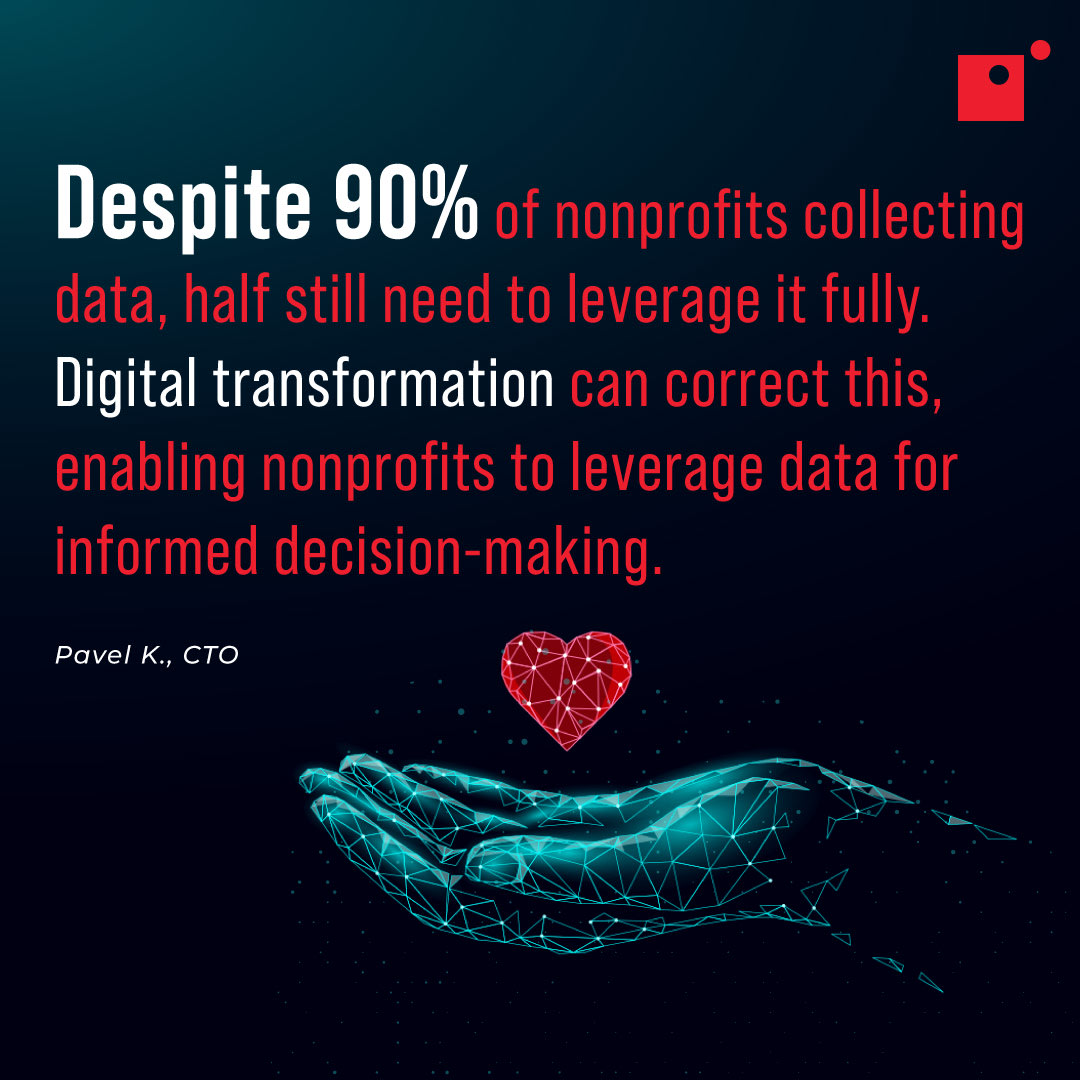The nonprofit sector is an important piece of our economy as nonprofit organizations focus on raising money to solve social issues, providing aid to those in need, and bettering the community. With such lofty goals, any process improvement can have a big impact on these institutions, making it critical that leaders and decision-makers adopt modern technologies and embrace nonprofit digital transformation.
The objectives of nonprofits are essential; whether it’s fighting climate change or poverty, it’s in the interests of everyone that they have the tools they need to succeed.
“Tech is no longer just infrastructure or an overhead cost. It's non-negotiable and infused into program execution and outreach to communities. It’s essential to nonprofits’ success in achieving their missions, leading to increased gains in their overall impact according to the Salesforce Nonprofit Trends Report.”
To meet their goals, nonprofits must review their processes and be willing to adopt new-aged technologies. Continue reading to learn more about the importance of nonprofit digital transformation, the benefits that stem from embracing a digital transformation, and the challenges that many nonprofits face on this path.
Building momentum with small projects is one of the best ways to start a full-force digital transformation. Learn how to get the ball rolling in Impact’s webinar, Fast-Tracking Your Digital Transformation!
Embracing Digital Transformation for Nonprofits
Embracing digital transformation is crucial for nonprofits to remain effective and sustainable in an increasingly digital world. This is because these initiatives enable nonprofits to streamline their operations, enhance their outreach, and improve their influence.
- Improved efficiency: By adopting digital tools and technologies, nonprofits can automate routine tasks, reduce administrative overhead, and allocate more resources to their core mission. This efficiency not only saves time and money but also allows staff and volunteers to focus on strategic initiatives and direct service delivery, ultimately increasing the organization’s capacity to achieve its goals.
- Donor Engagement: Digital transformation also strengthens a nonprofit’s ability to engage with donors, volunteers, and beneficiaries. Leveraging digital platforms for fundraising, communication, and program delivery opens up new avenues for reaching a broader audience. Social media, email marketing, and online donation systems make it easier to connect with supporters, share success stories, and mobilize resources quickly.
- Personalization: Moreover, digital tools like data analytics and customer relationship management (CRM) systems provide valuable insights into donor behaviors and preferences, enabling more personalized and effective engagement strategies. This improved interaction fosters stronger relationships and drives greater support for the organization’s mission.
- Transparency: Furthermore, digital transformation is essential for ensuring transparency and accountability in nonprofit operations. Advanced digital tools facilitate robust data management and reporting capabilities, allowing nonprofits to track their activities, measure outcomes, and demonstrate their impact to stakeholders.
Transparent reporting builds trust with donors, grantmakers, and the public, which is vital for securing ongoing support and funding. In an era where donors increasingly demand proof in results and efficiency, a nonprofit’s ability to present accurate, real-time data can significantly contribute to its credibility and creates a competitive edge.
Benefits of Digital Transformation for Nonprofits
Digital transformation provides nonprofit organizations with significant advantages, fundamentally enhancing their capacity to fulfill their mission and achieve sustainable growth.
One major benefit is the ability to leverage data analytics for strategic decision-making. By collecting and analyzing data from various sources, nonprofits can gain valuable insights into the needs of their beneficiaries, the efficacy of their programs, and the preferences of their donors.
This data-driven approach allows organizations to make informed decisions, tailor their services, and allocate resources more effectively, ultimately maximizing their contributions to society.
Another key benefit is the improved ability to collaborate and innovate. Digital tools facilitate better communication and collaboration among staff, volunteers, and partners, enabling more agile and creative problem-solving.
For example, virtual collaboration platforms allow teams to work together seamlessly, regardless of their physical locations, fostering a culture of innovation and continuous improvement. This capability is particularly important in the nonprofit sector, where organizations often face complex and evolving challenges that require innovative solutions.
Furthermore, digital transformation enables nonprofits to expand their reach and scale their efforts more effectively. Through digital channels, organizations can engage with a global audience, attract new supporters, and mobilize resources quickly. Additionally, online fundraising campaigns, virtual events, and social media advocacy can significantly amplify a nonprofit's message and attract diverse support.
This expanded reach not only increases awareness of the organization's mission but also opens up new opportunities for partnerships and collaborations.
By leveraging digital technologies, nonprofits can enhance their strategic capabilities, improve their operational efficiency, and ultimately achieve their mission more effectively and sustainably.
Common Challenges Solved with Digital Transformation
Beyond the general benefits that stem from pursuing a digital transformation, there are a number of common challenges that nonprofits face that the right technology can fully address, like:
- Missed engagement opportunities
- Outdated campaigns
- Poor audience segmentation and targeting
- Lack of collaboration
Missed Opportunities for Engagement
Nonprofit digital transformation addresses missed engagement opportunities by leveraging technology that bolsters communication and outreach. Traditional methods, like in-person events and direct mail, have limited reach and scalability.
Digital tools such as social media, email marketing, and online fundraising platforms enable nonprofits to connect with a broader audience in real-time, ensuring that messages are timely and relevant. For instance, through social media, nonprofits can share updates, success stories, and urgent appeals, instantly reaching thousands of followers and fostering a sense of community.
Further, digital transformation facilitates personalized engagement, crucial for building strong relationships with supporters. Personalized emails, targeted social media ads, and customized donation appeals increase engagement rates and donor retention. Recognizing a donor’s past contributions in thank-you emails or tailoring appeals to their interests can deepen their connection to the organization.
Additionally, digital transformation enables nonprofits to engage supporters through innovative and interactive experiences. Virtual events, webinars, and online workshops provide new avenues for involvement, especially for those unable to attend in-person events. These digital experiences offer live Q&A sessions, real-time polls, and interactive discussions, enhancing participant engagement.
Gamification strategies, such as online challenges and reward systems, make participation fun and motivating, encouraging more people to support the cause. By adopting these digital tools, nonprofits can connect with a wider audience, build stronger relationships, and create dynamic engagement opportunities.
Outdated Campaign Methods
Digital transformation can also help nonprofits modernizes campaigns by integrating advanced digital tools and platforms that streamline management, execution, and evaluation. Traditional methods relied on manual processes and physical outreach, which were time-consuming and limited.
Digital tools enable quick and efficient campaign launches with automation features, ensuring consistent and timely communication while freeing up staff for strategic planning and creative content development.
In addition to expanding the reach and scalability of campaigns, digital transformation provides robust tools for real-time monitoring and evaluation of campaign performance. Analytics platforms offer insights into metrics like click-through rates, conversion rates, and social media engagement, allowing nonprofits to adjust strategies on the fly.
This agility ensures that campaigns remain effective and impactful throughout their duration. By leveraging these digital capabilities, nonprofits can run more efficient, engaging, and adaptable campaigns, ultimately pushing them closer to their goals.
Poor Audience Segmentation and Targeting
Implementing modern technologies also addresses poor audience segmentation and targeting by leveraging advanced data analytics and customer relationship management systems. These tools enable nonprofits to collect and analyze detailed data on donor behaviors, preferences, and demographics, allowing for precise audience segmentation.
By understanding the unique characteristics and motivations of each segment, nonprofits can tailor their messaging and outreach strategies to better meet the needs and interests of different supporter groups.
Additionally, digital transformation improves targeting accuracy through sophisticated marketing automation platforms. These platforms track interactions across multiple channels, providing a comprehensive view of each supporter’s journey. With this information, nonprofits can deliver personalized content and appeals at the most opportune times.
For example, supporters who engage with environmental campaigns on social media might receive targeted updates and donation requests related to environmental initiatives, ensuring that the content aligns with their interests and past behaviors.
Moreover, digital transformation enables real-time monitoring and adjustment of segmentation and targeting strategies. Analytics dashboards provide immediate feedback on campaign performance, allowing nonprofits to quickly identify what works and what needs improvement.
This approach ensures continuous optimization of audience engagement strategies, leading to more effective outreach and higher donor satisfaction and retention.
Lack of Cross-Departmental Communication
Finally, digital transformation tackles challenges with internal collaboration by introducing advanced communication and workspace tools. Digital platforms such as cloud-based collaboration tools and instant messaging applications facilitate real-time communication and file sharing across teams, regardless of location.
This fosters a more cohesive work environment where information flows freely and teams can collaborate seamlessly on shared projects. Teams can collaborate on shared documents, monitor project progress in real time, and provide immediate feedback within centralized digital workspaces.
For example, fundraising teams can coordinate efforts with program staff to align campaigns with organizational goals, ensuring consistency and maximizing results through combined expertise.
Overall, digital transformation empowers nonprofits to operate more cohesively, innovate effectively, and achieve greater impact in their mission-driven initiatives.
Digital Maturity Among Nonprofits
In short, digital maturity refers to an organization's level of competence in integrating digital technologies into its operations, strategy, and culture. It encompasses the extent to which an organization effectively leverages digital tools and data to support decision-making, improve efficiency, and drive innovation, resulting in sustained growth and competitive advantage.
The benefits of achieving digital maturity are clear, but many nonprofit organizations are still struggling to develop, invest in, and integrate a technology strategy that meets today’s needs.
“In its 2022 Nonprofit Trends Report, Salesforce identified only one in eight nonprofits worldwide as digitally mature—a measure of how advanced those organizations are in using technology and data.”
This tells us that not even 13% of nonprofit organizations have reached digital maturity worldwide which further demonstrates how much opportunity exists in nonprofit digital transformation. This is especially because high levels of digital maturity are directly correlated with stronger fundraising and efficiency.
“Digitally mature organizations are more likely to exceed fundraising goals and report stronger relationships with stakeholders. Those with high digital maturity were almost twice as likely as non-digitally mature organizations to report improvements in organizational efficiency and are 3.5 times more likely to achieve mission goals.”
Final Thoughts on Nonprofit Digital Transformation
No matter which sector your organization falls into, business technology and digital transformation need to be priorities in your institution. From streamlining processes to significantly improving the employee experience and amplifying productivity, the right technology can revolutionize the way organization operates.
For nonprofits, implementing modern technology is especially critical in facilitating digital contributions through websites or mobile apps, distributing marketing, and ultimately, changing the world for the better by reaching their development goals.
There are many ways to launch a digital transformation initiative, but if you want to get your digital transformation journey started on the right foot, watch Impact’s webinar, Fast-Tracking Your Digital Transformation!





